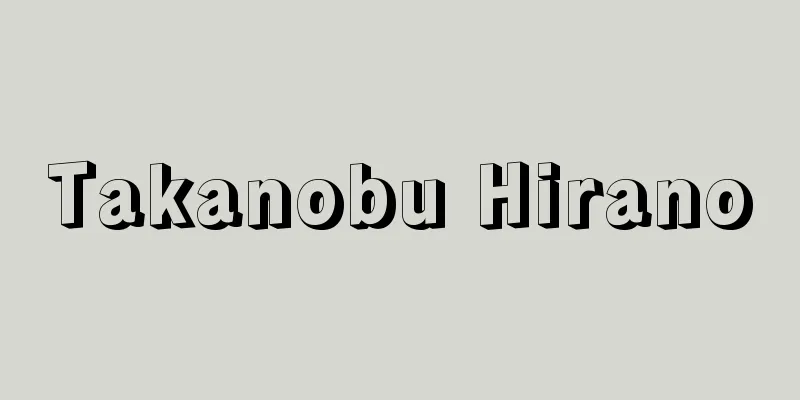Meson - meson (English spelling)

|
Among the elementary particles that make up matter, those that strongly interact with each other are classified as hadrons, and among these, particles with a half-integer spin (the inherent angular momentum of an elementary particle) are called baryons, while particles with an integer spin are called mesons. Typical heavy particles are the protons and neutrons (collectively called nucleons) that make up the atomic nucleus, and a typical meson is the π (pi) meson, whose existence was predicted by Hideki Yukawa, and there are three types (π + , π 0 , π - ) with electric charge (elementary electric quantity unit) Q = +1, 0, -1. Both have spin J = 0, parity (even-oddness) P is negative (expressed as J P = 0 - ), and masses are almost the same. If we count separately those that share quantum numbers such as J P and have almost the same mass but differ only in electric charge, several hundred mesons have been discovered so far. [Akio Ohtsuki] Yukawa theory Yukawa's meson theory was published in 1935, and in 1949 he was awarded the Nobel Prize (in physics), becoming the first Japanese to do so. It had already been made clear in 1932 that the atomic nucleus, which together with electrons makes up an atom, is a binding system of nucleons. However, the force that binds nucleons together, the nuclear force, is about 100 times stronger than the Coulomb force that acts between charged particles, but has the characteristic that it only acts over small distances, about the size of the atomic nucleus, and its true nature was completely unknown at the time. Yukawa believed that the nuclear force is generated by the exchange of unknown particles called U particles between nucleons. In this way, the potential energy of the nuclear force between two nucleons separated by a distance r is Yukawa also attempted to explain beta decay by hypothesising that U particles emitted from nucleons decay into electrons and neutrinos. In this respect, the Yukawa theory is one of the precursors to the unified theory of particle physics, which attempts to treat various interactions in nature in a unified manner. [Akio Ohtsuki] Unified theoryIn 1937, particles with mc 2 to 100 MeV were discovered in cosmic rays. Contrary to the predictions of the Yukawa theory, they did not strongly interact with atomic nuclei. This led Shoichi Sakata and others to consider that the μ (mu) particle was different from the U particle, and that there were two types of mesons (two-meson theory, 1942). The pion, which has the expected strong interaction, was discovered in cosmic rays in 1947, and was artificially produced in an accelerator the following year. The mass of π ± is mc 2 = 140 MeV, and that of π 0 is 135 MeV. The nuclear force in the region outside r r 0 is expressed by the Yukawa potential due to the exchange of pion mesons, but in the inner region r ≪ r 0, it becomes complicated as mesons with large masses also mediate. The muon, along with the electron and neutrino, is classified as a spin 1/2 lepton family (light particle family) that does not interact strongly. [Akio Ohtsuki] Meson structureA meson is a bound system of a quark q with spin J = 1/2 and its antiparticle bound by the force mediated by gluons. Gluons also have a quantum number called "color charge," and are thought to be all confined inside mesons due to the force properties of quantum chromodynamics. Let me give a few examples. The quarks with the smallest mass, i.e. the lightest, are the u quark with charge Q = 2/3 and the d quark with charge Q = -1/3. The pions are these and their antiparticles u and ( The Q of the antiquark has the opposite sign . ) , π 0 to u u and d , π - ~ d ū . The angular momentum of the rotation between these q 's is zero, and their spins are antiparallel (spin singlet), so the pion has a J P = 0 - . The next heaviest after u and d is the s quark with Q = -1/3, which has a quantum number S = -1, known as strangeness. Replacing u with s in π + gives us S = -1. 0 to s mc 2 = 498 MeV, and by replacing with (the antiquark S has the opposite sign), we get S = +1 K + ~ u At mc 2 = 970 MeV, the energy is 494 MeV. Thus, J P = 0 - is the common energy, and there are eight types of mesons, including π, with different Q and S , all below mc 2 = 547 MeV. The next heaviest are the nine types of mesons with J P = 1 - , which appear at mc 2 = 771 to 1019 MeV. After s , in order of increasing weight, there are the quarks c ( Q = 2/3, quantum number charm = 1), b ( Q = -1/3, quantum number bottom = -1), and t ( Q = 2/3, quantum number top = 1), and heavy mesons that contain these, such as the mesons γ to b with mc 2 = 9460 MeV, In addition, heavy mesons generally decay into lighter mesons through the strong interaction, but the lightest meson, the pion, has no decay partner through the strong interaction, and so π ± decays into μ ± and a neutrino, and π 0 decays into two photons. In quantum field theory, it is known that massless, spinless Nambu-Goldstone particles appear when symmetry is broken spontaneously. Among the many mesons, the particularly light π meson is also considered to be a Nambu-Goldstone particle that accompanies the spontaneous breaking of chiral symmetry specific to the u and d quarks, which have masses close to zero, but it is thought that the π meson has a small mass because this symmetry is not perfect. [Akio Ohtsuki] "Elementary Particles" by Hara Yasuo (1980, Asakura Shoten)" ▽ "Composite Models of Elementary Particles" by Ogawa Shuzo, Sawada Shoji, and Nakagawa Masami (1980, Iwanami Shoten)" ▽ "Exploring the Ultimate Nature of Matter - A Modern Unified Theory" edited by the Physical Society of Japan (1982, Baifukan)" ▽ "The Discovery of the Top Quark" by Kondo Miyako (1996, Maruzen)" ▽ "Quarks - How Far Has Elementary Particle Physics Come? 2nd Edition by Nambu Yoichiro (Kodansha, Bluebacks)" ▽ "Traveller: Recollections of a Physicist" by Yukawa Hideki (Kadokawa Bunko) [References] | | | | | | | |Source: Shogakukan Encyclopedia Nipponica About Encyclopedia Nipponica Information | Legend |
|
物質を構成する素粒子のうち互いに強く相互作用をするものはハドロン族に分類され、そのうちスピン(素粒子の固有の角運動量)が半整数の粒子は重粒子(バリオン)、整数の粒子は中間子(メソン)とよばれる。代表的な重粒子は原子核を構成する陽子と中性子(核子と総称)、代表的な中間子は湯川秀樹(ゆかわひでき)がその存在を予言したπ(パイ)中間子で、電荷(電気素量単位)Q=+1,0,-1の3種類(π+,π0,π-)がある。ともにスピンJ=0、パリティ(偶奇性)Pは負(JP=0-と表す)で質量もほぼ等しい。このようにJPなどの量子数を共有し質量もほぼ等しいが電荷だけが異なるものを別々に数えるといままでに百数十個の中間子が発見されている。 [大槻昭一郎] 湯川理論湯川の中間子論は1935年に発表され、1949年日本人最初のノーベル賞(物理学賞)を授与された。電子とともに原子を構成する原子核が核子の束縛系であることはすでに1932年に明らかになっていたが、核子を結合させる力、核力、は荷電粒子の間に働くクーロン力と比べると、強さは100倍程度大きい一方で原子核の大きさ程度の小さい距離でしか働かないという特徴があり、その本性は当時まったく不明であった。湯川は核力はU粒子という未知の粒子が核子の間に交換されることによって生じると考えた。こうすると距離r離れた2個の核子の間の核力の位置エネルギーは 湯川はさらに、核子から放出されたU粒子が電子とニュートリノとに崩壊するとしてβ崩壊をも説明しようとした。この面で湯川理論は、自然界のさまざまな相互作用を統一的に扱おうとする素粒子物理学の統一理論の先駆の一つをなすものである。 [大槻昭一郎] 統一理論1937年宇宙線中に発見されたmc2~100MeVの粒子が湯川理論の予想に反して原子核と強くは相互作用をしないことから、坂田昌一(しょういち)らは、このμ(ミュー)粒子はU粒子とは別物で2種類の中間子が存在すると考えた(二中間子論、1942)。期待されたとおりの強い相互作用をするπ中間子は1947年宇宙線中で発見され、翌年加速器で人工的に生成された。π±の質量はmc2=140MeV、π0のそれは135MeVである。なお、rr0の外のほうの領域の核力はπ中間子の交換による湯川ポテンシャルで表されるが、内側のr≪r0では質量が大きい中間子も媒介するなど複雑になる。また、μ粒子は電子やニュートリノなどとともに強い相互作用をしないスピン1/2のレプトン族(軽粒子族)に分類される。 [大槻昭一郎] 中間子の構造中間子はスピンJ=1/2のクォークqとその反粒子がグルーオンの媒介する力で結合した束縛系である。q、およびグルーオンは「色(いろ)電荷」とよばれる量子数をもち、量子色力学による力の特性からすべて中間子の内部に閉じ込められると考えられている。 二、三例をあげよう。クォークのうちもっとも質量が小さい、すなわち軽いのは電荷Q=2/3のuクォークとQ=-1/3のdクォークであるが、π中間子はこれらとその反粒子ū、(反クォークのQは逆符号)の束縛系としてπ+~u、π0~uūおよびd、π-~dūである。これらqとの間の回転の角運動量はゼロ、互いのスピンは反平行(スピン1重項)で、その結果π中間子はJP=0-となる。u、dに次いで重いのはストレンジネスとよばれる量子数S=-1をもつQ=-1/3のsクォークで、π+でuをsに入れ替えたのがS=-1の0~sでmc2=498MeV、またを(反クォークのSは逆符号)に入れ替えたのがS=+1のK+~uで494MeV。このようにJP=0-は共通でQ、Sが異なるπを含めた8種類の中間子がmc2=547MeV以下にそろっている。次に重いものとしてJP=1-の9種類の中間子がmc2=771~1019MeVに現れる。sに次いで重くなる順にc(Q=2/3、量子数チャーム=1)、b(Q=-1/3、量子数ボトム=-1)、t(Q=2/3、量子数トップ=1)のクォークが存在し、これらを含んだ重い中間子、たとえばmc2=9460MeVの中間子γ~bなども、多数発見されている。なお、重い中間子は一般的には強い相互作用で軽い中間子へと崩壊するが、もっとも軽いπ中間子は強い相互作用による崩壊相手がなく、π±はμ±とニュートリノへ、π0は2個の光子へ、それぞれ崩壊する。 場の量子論では対称性が自発的に破れるとき質量ゼロ、スピンゼロの南部・ゴールドストーンの粒子が出現することが知られている。数ある中間子のなかで特別に軽いπ中間子は、質量がゼロに近いu、dクォークに特有のカイラル対称性の自発的破れに伴う南部・ゴールドストーンの粒子ともみなされるが、この対称性が完璧(かんぺき)でない分だけπ中間子が小さい質量をもつと考えられる。 [大槻昭一郎] 『原康夫著『素粒子』(1980・朝倉書店)』▽『小川修三・沢田昭二・中川昌美著『素粒子の複合模型』(1980・岩波書店)』▽『日本物理学会編『物質の窮極を探る――現代の統一理論』(1982・培風館)』▽『近藤都登著『トップクォークの発見』(1996・丸善)』▽『南部陽一郎著『クォーク――素粒子物理はどこまで進んできたか』第2版(講談社・ブルーバックス)』▽『湯川秀樹著『旅人 ある物理学者の回想』(角川文庫)』 [参照項目] | | | | | | | |出典 小学館 日本大百科全書(ニッポニカ)日本大百科全書(ニッポニカ)について 情報 | 凡例 |
<<: Intermediate facility - Chukan Shisetsu
Recommend
Adjuvant - Hojozai (English spelling)
Substances added to maintain or enhance the effica...
NNS - Networking System
A satellite used in the U.S. Navy 's Satellite...
Sedum oryzifolium (English name) Sedumoryzifolium
… [Hiroshi Yuasa]. … *Some of the terminology tha...
Masaaki Asanuma
...Yamawaki Toyo, a Kyoto government physician wh...
Franco Sacchetti
Italian poet and novelist. Born into a distinguis...
NGd - N.G.D.
...A nitramine compound first synthesized in 1877...
Sobornoe ulozhenie (English spelling)
…He deposed Morozov and convened a national assem...
Fujiwara Kunitsuna - Fujiwara no Kuni Tsuna
An aristocrat in the late Heian period. His fathe...
Japanese mathematics - Wasan
Mathematics that developed uniquely in Japan duri...
Battle of Eikyou Yamato
...The Shocho peasant uprising was triggered by t...
Kinsuke Town
... After the Genna and Kan'ei periods (1615-...
Alpweiden
...Generally, coniferous forests are densely popu...
Sunthonphu (English spelling)
1785‐1855 Thailand's greatest poet. Sunthongpu...
Kineya Rokuzaemon (9th generation)
...Lyrics by Segawa Jyoko II. Music by Kineya Rok...
Nursing intervention
...By meeting the needs of the patient in accorda...









